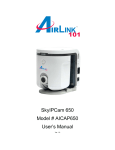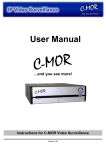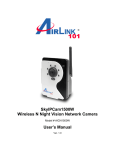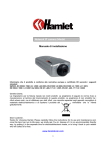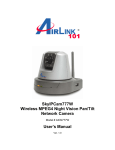Download AirLink AIC250 surveillance camera
Transcript
SkyIPCam 250 Network Camera Model # AIC250 User’s Manual Ver. 1B Table of Contents 1. Introduction................................................................................................................................. 4 2. Getting Started ............................................................................................................................ 5 3. Installing the Setup Wizard......................................................................................................... 6 4. Gathering Information ................................................................................................................ 8 5. Using the Setup Wizard .............................................................................................................. 9 6. Viewing Images ........................................................................................................................ 14 7. Web Configuration Utility ........................................................................................................ 16 7.1.1 Management – System..................................................................................................... 17 7.1.2 Management – Video....................................................................................................... 18 7.1.3 Management – Network................................................................................................... 18 7.1.4 Management – User ......................................................................................................... 19 7.2.1 Configuration – System ................................................................................................... 19 7.2.2 Configuration – Video ..................................................................................................... 20 7.2.3 Configuration – Network ................................................................................................. 21 7.2.4 Configuration – User........................................................................................................ 22 7.2.5 Configuration – Date & Time .......................................................................................... 23 7.2.6 Configuration – Upload ................................................................................................... 24 7.2.7 Configuration – E-mail .................................................................................................... 25 7.3.1 Tools – FTP Server Test .................................................................................................. 26 7.3.2 Tools – E-mail Test.......................................................................................................... 26 7.3.3 Tools – Reset.................................................................................................................... 27 7.3.4 Tools – Factory Reset ...................................................................................................... 27 7.3.5 Tools – Firmware Upgrade .............................................................................................. 28 7.3.6 Tools – Backup ................................................................................................................ 29 7.4.1 Help – About.................................................................................................................... 29 8. Viewing Videos from External Networks................................................................................. 30 9. IPView Pro................................................................................................................................ 33 9.1 Installing IPView Pro.......................................................................................................... 33 9.2 Starting IPView Pro ............................................................................................................ 35 9.2.1 Adding Camera using the Search Method ....................................................................... 36 9.2.2 Adding Camera using the Input IP Method ..................................................................... 40 9.3 Using IPView Pro ............................................................................................................... 42 9.3.1 Status Mode Window....................................................................................................... 43 9.3.2 View Window and View Mode Buttons.......................................................................... 45 9.3.3 Control Panel ................................................................................................................... 46 9.4 System Configuration ......................................................................................................... 48 9.4.1 Camera Configuration...................................................................................................... 48 9.4.2 Web Configuration........................................................................................................... 49 9.4.3 Motion Configuration-1 ................................................................................................... 50 9.4.4 Motion Configuration-2 ................................................................................................... 51 9.4.5 Tools ................................................................................................................................ 52 9.4.6 Mail Configuration........................................................................................................... 53 9.4.7 Proxy Server..................................................................................................................... 54 9.4.8 Recording Configuration ................................................................................................. 55 2 9.4.9 Schedule-Recording Configuration ................................................................................. 56 9.4.10 Others............................................................................................................................. 58 9.4.11 Log List.......................................................................................................................... 59 9.4.12 Account .......................................................................................................................... 60 9.4.13 About.............................................................................................................................. 61 10. Xplug Control ......................................................................................................................... 62 10.1 Installing Xplug Control ................................................................................................... 62 10.2 Enabling ActiveX.............................................................................................................. 63 Appendix....................................................................................................................................... 66 Sending Images via Web Browser............................................................................................ 66 Technical Support ......................................................................................................................... 71 3 1. Introduction Congratulations on your purchase of this SkyIPCam 250. The IP Camera allows you to view images and live videos from internal and external networks. With a built-in CPU and Web Configuration Utility, the IP Camera is a standalone network device that delivers high quality videos at a low cost of ownership. The built-in Web Configuration Utility allows any computer that’s connected to the network to remotely manage the IP Camera. Combined with the bundled Setup Wizard and IPView Pro software, managing and viewing multiple IP Cameras is simple and efficient. Instructions for installing and configuring this product can be found in this manual. Before you install and use this product, please read this manual carefully for proper operation of the product. Package Contents Before you begin the installation, please check the items of your package: • • • • • SkyIPCam 250 Camera Stand AC Power Adapter Quick Installation Guide Utility CD If any item contained is damaged or missing, please contact your local dealer immediately. Also, keep the box and packaging materials in case you need to ship the unit in the future. 4 2. Getting Started Note: Before using the IP Camera, you’ll need to perform the following tasks: 1. Connect the IP Camera to your network. 2. Install the Setup Wizard. 3. Gather information about your local network address. 4. Configure the IP Camera using the Setup Wizard. Please follow the steps in this Manual carefully to ensure proper setup of the IP Camera. Caution: The IP Camera is designed for indoor use only. Direct exposure to sunlight may cause permanent damage to the CMOS sensor. When operating in extremely bright environment, an iris lens or sun visor is recommended to protect the IP Camera. Step 1 Connect one end of a network cable to the IP Camera and connect the other end to one of the LAN ports of the router or switch (See the diagram below). Step 2 Power on the IP Camera by connecting one end of the supplied power adapter to the power jack of the Camera and connecting the other end to an electrical outlet. Step 3 Verify that all the lights on the Camera are lit. If not, verify that all the connections are secure and try again. 5 3. Installing the Setup Wizard Step 1 Insert the provided CD and wait for the autorun screen to appear. Step 2 Click on Install Wizard. Note: If the autorun screen does not appear automatically, go to Start, Run, type D:\autorun.exe (where D is the letter of your CD drive) and click OK. Step 3 Click Next. 6 Step 4 Click Yes to accept the License Agreement. Step 5 Click Next to accept the default Destination Folder. Step 6 Click Finish to complete the installation. 7 4. Gathering Information Note: Before using the Setup Wizard, you’ll need to take note of your local network address. Step 1 Click on Start, Run, and type command (for Windows 95/98/ME) or cmd (for Windows 2000/XP) and click OK. The command prompt will appear. Step 2 At the command prompt, type ipconfig and press Enter. Step 3 Write down the information for the IP Address, Subnet Mask, and Default Gateway. You will need these information later. 8 5. Using the Setup Wizard Step 1 Go to Start > (All) Programs > AirLink101 IP Camera Setup Wizard. Step 2 Select the IP Camera you want to configure from the list and click on the Wizard button. 9 Step 3 If the Camera’s default IP Address is on a different subnet, the following message will appear. Click Yes to continue. Note: If you do not receive this message, skip to Step 9. Step 4 Enter admin for both the Admin ID and Password and click OK. Step 5 In the IP Address field, change the first three numbers to match your local network address. For example: If your computer’s IP Address is 192.168.2.100, change the first three numbers to 192.168.2 as well but leave the last number 240 alone. 10 Step 6 Enter the Subnet Mask and Gateway fields with exactly the same values as you got from running ipconfig. Click OK to continue. Step 7 After the Camera has restarted, click the Exit button to close the Setup Wizard. Step 8 Start the Setup Wizard again and make sure the Current IP Address field displays the new IP Address. Select the Camera and click on the Wizard button. 11 Step 9 The Setup Wizard appears asking you to change the Admin ID and Password. The default Admin ID and Password is admin. Step 10 Enter admin for both the Admin ID and Password field, click on the Change checkboxes and enter the New ID and New Password and click Next. 12 Step 11 If you need to change the Camera’s IP Address because another network device is already using the same address, you can assign a new address here and click Next. Step 12 Verify all the fields are correct and click Restart to save the settings and reboot the Camera. 13 6. Viewing Images Note: The following steps describe how to view images from within the same local area network as the IP Camera. To view images from an external network such as the Internet, please refer to Section 8 of this manual for further instructions. Step 1 At the Setup Wizard, select the desired camera from the list and click on the Web Config button. Step 2 The default page appears. You can view live video by selecting either the ActiveX Mode (Internet Explorer) or the Java Mode (Internet Explorer and Netscape). 14 Step 3 Turn the Camera’s lens clockwise or counter-clockwise to focus. Note: ActiveX and/or Java Applet must be installed and enabled on your Web Browser (Internet Explorer or Netscape) before you can view the live videos. Step 4 If you need to install Java Virtual Machine on your computer, do not follow the on-screen XP instructions. Rather, go to http://www.java.com/en/download/manual.jsp and follow the instructions on that web site to download and install the required Java software. The IP Camera is ready for use now. 15 7. Web Configuration Utility The built-in Web Configuration Utility allows you to remotely manage the IP Camera with the ease and convenience of your Web Browser (Internet Explorer or Netscape). Step 1 Open your Web Browser (Internet Explorer or Netscape), enter the default IP Address of the Camera 192.168.1.240 in the Address Bar and press Enter. Note: If you have changed the IP Address of the Camera as described in Section 5, enter the Camera’s new IP Address instead of the default. Step 2 Click on System Administration to enter the Web Configuration Utility. Step 3 Enter admin for both the User name and Password or enter the new User name and Password that you have previously specified and click OK. 16 The Management page appears by default. You can select different pages at the Top Menu Bar, while Sub-menus for each page are available at the left-hand side. 7.1.1 Management – System The Management – System page displays the Device and Ethernet Status of the Camera. You can click on Refresh to update the page. 17 7.1.2 Management – Video The Management – Video page displays the Video Status of the Camera. You can click on Refresh to update the page. 7.1.3 Management – Network The Management – Network page displays the Network Status of the Camera. You can click on Refresh to update the page. 18 7.1.4 Management – User The Management – User page displays all the Active Users who are currently connected to the Camera. You can click on Refresh to update the page. 7.2.1 Configuration – System The Configuration – System page allows you to configure the System Settings of the Camera. Camera Name: You can assign a user-friendly name for the camera. Location: Enter the location of the camera. Admin ID: Specify a username for the Admin account. Admin Password: Specify a password for the Admin account. LED Control: Normal: Both Pwr and Lnk LEDs are ON. When LAN activity is present, Lnk will flash. OFF: Both Pwr and Lnk LEDs are OFF. Dummy: Both Pwr and Lnk LEDs are ON with Lnk flashing randomly. Click Save to apply the new settings. 19 7.2.2 Configuration – Video The Configuration – Video page allows you to configure the Video Settings of the Camera. Video Resolution: Select the desired video resolution. Compression Rate: Select the desired video compression rate. Higher compression rate yields smaller file size but with less video quality and vice versa. Frame Rate: Select the desired frame rate. Brightness Control: Adjust the brightness level. Contrast Control: Adjust the contrast level. Saturation Control: Adjust the saturation level. Light Frequency: Adjust the light frequency. Mirror: Select to apply horizontal or vertical mirroring. Anti-Flicker: Check to enable anti-flicker. Click Save to apply the new settings. 20 7.2.3 Configuration – Network The Configuration – Network page allows you to configure the Network (TCP/IP) Settings of the Camera. IP Address Mode: Fixed IP: Assign a static IP Address for the Camera (recommended) Dynamic IP: Receives a dynamically assigned IP Address from the router of DHCP server. PPPoE: If the camera is directly connected to a DSL modem, enter your DSL username and password here and the Camera will automatically receive an IP address from your ISP. 21 DNS IP Address: Enter your ISP’s DNS IP Address here if you want to host videos over the Internet. Dynamic DNS: Select to enable or disable Dynamic DNS (DDNS). You must register with one of the Service Providers listed in the drop-down menu first then enter your account information in the applicable fields. Second HTTP Port: Select to enable or disable the Second HTTP Port. If you want to host videos over the Internet, you must enable the Second HTTP Port and assign a port number that’s not in use by another application. UPnP: Select to enable or disable Universal Plug-and-Play. Click Save to apply the new settings. 7.2.4 Configuration – User The Configuration – User page allows you to configure the User Access Control of the Camera. You can create additional user accounts to allow them to monitor the Camera from remote locations. Select to Enable or Disable User Access Control. To add a new user, enter the new User Name and Password. Specify whether the new user can upload/e-mail the video or not. Click Add to add the new user to the User List. Click Save to apply the new settings. 22 7.2.5 Configuration – Date & Time The Configuration – Date Time page allows you to configure the Date & Time Settings of the Camera. Synchronized with Time Server: The date and time will be synchronized with the Time Server you’ve specified. IP Address: Enter the IP Address of the Time Server Protocol: Select either NTP or Time as your protocol TimeZone: Select your time zone based on the GMT setting. Set Manually: Manually set the Date and Time for the Camera. Date: Enter the current date. Time: Enter the current time. Synchronized with Computer Time: Check this box to synchronize the Camera’s time with your computer’s time. Click Save to apply the new settings. 23 7.2.6 Configuration – Upload The Configuration – Upload page allows you to configure the Upload Settings of the Camera. FTP Server: Enter the information for the FTP server that you want to upload the images to. Time Schedule: You can setup a time schedule to always upload or periodically upload images to the designated FTP server. Manual Operation: When you click on the Upload Video ON button in the view image screen, it will start to upload the image and save the image with the file name specified in the Base File Name field. Click Save to apply the new settings. 24 7.2.7 Configuration – E-mail The Configuration – E-mail page allows you to configure the E-mail Settings of the Camera. E-mail Account: Enter the information for your SMTP E-mail account that you want to e-mail the images to. Time Schedule: You can setup a time schedule to always e-mail or periodically e-mail images to the designated e-mail account. Manual Operation: When you click on the E-mail Video ON button in the view image screen, it will start to e-mail the images at the designated interval to the specified e-mail account. Click Save to apply the new settings. 25 7.3.1 Tools – FTP Server Test The Tools – FTP Server Test page allows you to test the FTP Server Settings of the Camera. Click on Test to perform the test. A jpeg file will be uploaded to the FTP server you specified. 7.3.2 Tools – E-mail Test The Tools – E-mail Test page allows you to test the E-mail Settings of the Camera. Click on Test to perform the test. An e-mail will be sent to the e-mail account you specified. 26 7.3.3 Tools – Reset The Tools – Reset page allows you to Reset the Camera. Click on Yes to perform the reset. 7.3.4 Tools – Factory Reset The Tools – Factory Reset page allows you to perform a Factory Reset on the Camera. Click on Yes to reset the Camera and return all the settings to the factory default. Note: Performing a factory reset will erase all of your previously saved settings. 27 7.3.5 Tools – Firmware Upgrade The Tools – Firmware Upgrade page allows you to upgrade the Camera firmware. You can check our website at www.airlink101.com to see if there is a newer firmware available for download. Step 1 Download the new firmware from our web site at www.airlink101.com Step 2 Unzip the new firmware. Step 3 Click on the Browse button and locate the new firmware. Step 4 Click on the Upgrade button to begin the upgrade. 28 7.3.6 Tools – Backup The Tools – Backup page allows you to Backup and Restore the Camera’s settings. To backup the Camera’s settings to your computer, click on the Backup button. A window will appear asking for the save location. The settings will be saved as Config.bin To restore the saved settings, click on the Browse button, browse to the saved file, and click on the Restore button. 7.4.1 Help – About The Help – About page displays the Camera’s current firmware version. 29 8. Viewing Videos from External Networks If you want to access the Camera from an external network such as the Internet, please read the following example carefully and follow the steps. Before you begin, you’ll need to know your Internet IP Address (WAN IP) assigned by your Internet Service Provider (ISP) and at least one of your ISP’s DNS IP Address. You can usually find these information on the Status page of your router’s web configuration utility. If not, you’ll need to contact your ISP for assistance. Example: Network A = Location of the Camera Camera’s IP Address is 192.168.1.240 with Second HTTP Port 81 Enabled. Network A’s router has an Internet IP Address (WAN IP) of 172.16.1.1 assigned by the Internet Service Provider (ISP). The ISP’s DNS IP Address is 10.0.0.1 and 10.0.0.2 Network B = Location of the remote client trying to access the Camera. Step 1 From one of the computers in Network A, open the web browser (Internet Explorer or Netscape), enter the Camera’s IP Address 192.168.1.240 in the Address Bar and press Enter. Step 2 Click on System Administration to enter the Web Configuration Utility. 30 Step 3 Enter admin for both the User name and Password or enter the new User name and Password that you have previously specified and click OK. Step 4 Click on Configuration then Network. 31 Step 5 Enter your ISP’s DNS IP Address at the DNS IP Address field. Step 6 Select Enable for the Second HTTP Port and enter a Port Number for the Camera (default is 81). Important: You must assign a port number that’s not in use by any other application on your network. Step 7 Click Save to apply the new settings. Now the Camera with IP Address of 192.168.1.240 has port 81 Open. Step 8 From one of the computers in Network A, login to the web configuration utility of Network A’s router. Step 9 Navigate to the router’s Virtual Server or Port Forwarding page. Step 10 Enable Forwarding of port 81 to the Camera’s IP Address (192.168.1.240) and save the new setting. Step 11 From one of the computers in Network B, open the web browser (Internet Explorer or Netscape), enter the Internet IP Address (WAN IP) of Network A’s router (172.16.1.1) followed by a colon : and the port number of the Second HTTP Port (81) in the Address Bar and press Enter. Ex. http://172.16.1.1:81 The remote client in Network B should be able to see the images from the Camera now. 32 9. IPView Pro The bundled IPView Pro software features a user-friendly interface that allows you to manage, view, and configure multiple IP Cameras on your network. Follow the steps below if you wish to install and use this software. 9.1 Installing IPView Pro Step 1 Insert the provided CD and wait for the autorun screen to appear. Step 2 Click on Install IPView Pro. Note: If the autorun screen does not appear automatically, go to Start, Run, type D:\autorun.exe (where D is the letter of your CD drive) and click OK. Step 3 Click Next. 33 Step 4 Click Yes to accept the License Agreement. Step 5 Click Next to accept the default Destination Folder. Step 6 Click Finish to complete the installation. 34 9.2 Starting IPView Pro To start IPView Pro, go to Start > (All) Programs > Airink101 IPView Pro > Airlink101 IPView Pro The main screen will appear as below: 35 9.2.1 Adding Camera using the Search Method Before you can do anything, the camera must be added to the Camera List first. If you have more than one camera, you’ll need to add the additional cameras to the list as well. The Search Method is the easiest way to add your local cameras to the list. Step 1 Click on the System Configuration button. Step 2 The System Configuration Window will appear. This is where you configure all of your cameras that have been added to the Camera List. 36 Step 3 Verify your camera is connected to your network and is powered on. Click on the Search button. Step 4 Select your camera from the Add Camera list and click on Add Camera. 37 Step 5 Enter the User Name and Password for the camera. (Default is admin for both). Step 6 You should see your camera added to the Camera List. Step 7 Click Save to apply the changes. 38 Step 8 Click on the System Configuration button to close the System Configuration Window. You should now see live images from the camera. Note: If you want to add a camera located on a remote network (through the Internet), you must add the camera using the Input IP method described below. 39 9.2.2 Adding Camera using the Input IP Method An alternative way to add your local camera to the Camera List is to use the Input Method. If you want to add a camera located on a remote network (through the Internet), you must use this method as well. Step 1 Select the Input IP tab. Step 2a For local camera, enter the local IP Address of your camera and click Add Camera. Skip to Step 3. 40 Step 2b For remote camera, enter the Internet IP Address (WAN IP) of the remote router and the port number of the Second HTTP Port of the remote camera and click Add Camera. Step 3 Enter the User Name and Password for the camera. (Default is admin for both). Step 4 You should see your camera added to the Camera List. Step 5 Click Save to apply the changes. Step 6 Click on the System Configuration button to close the System Configuration Window. 41 9.3 Using IPView Pro This section describes the various features of IPView Pro. 42 9.3.1 Status Mode Window The Status Mode Window displays a list of cameras that are added to IPView Pro as well as the status of each selected camera. Select the desired camera from the list then click on the Change Status Mode button to view the status of the camera. 43 Use the Camera Buttons to control the camera’s various functions. From left to right: Connect/Disconnect: Connects or disconnects the video signals from the selected camera. Rotate Image Angle: Rotates the angle of the video. Snapshot: Takes a snapshot image of the current video. When you click on this button, a window will appear asking you to specify the image name and the save location. Audio: Disabled for this model. Zoom Mode: Adjusts the zoom setting of the camera. 44 9.3.2 View Window and View Mode Buttons The View Window displays video from the currently selected camera. Use the View Mode Buttons to select the desired viewing mode. From left to right: Up/Down Arrows: If you have more than one camera in your network, you can use the Up/Down Arrow Buttons to view the videos from each camera. View Modes: Select the desired view mode. The view window can display up to 16 cameras simultaneously. Full-Screen Mode: Displays the video in full-screen. Scan Mode: Scans through each camera at a set interval (in seconds). 45 9.3.3 Control Panel The Control Panel contains essential buttons for operating IPView Pro. Key Lock: The Key Lock button locks all the buttons on the IPView Pro for security purposes. If you have enabled a password login for IPView Pro, you’ll need to input the same password to unlock the key lock. Power: Click on the Power button and select to Exit or Minimize IPView Pro. Record: Click on the Record button and select Manual Record to record the video immediately to your hard drive. If you select Schedule Record or Motion Record, the camera will record the videos according to the corresponding settings in System Configuration. To stop recording, click on the Record button and select Manual Record again. 46 Play: Click on the Play button to playback the recorded videos from your hard drive. A window will appear asking you for the location of the recorded video. Select the desired video and click OK to begin playback. System Configuration: Click on the System Configuration Button to open the System Configuration Window. 47 9.4 System Configuration The System Configuration Window is where you configure the settings of IPView Pro and all the cameras that are added to the Camera List. 9.4.1 Camera Configuration The Camera Configuration page allows you to add the cameras in your network to IPView Pro’s Camera List. For instructions on how to do add your cameras, please refer to Section 9.2.1 Adding Camera Using the Search Method. 48 9.4.2 Web Configuration The Web Configuration page allows you to access the Web Configuration Utility of the selected camera. Use the drop-down menu to select the desired camera and click on System Administration to enter the camera’s Web Configuration Utility. 49 9.4.3 Motion Configuration-1 The Motion Configuration-1 page allows you to set the Motion Detection settings. Select the desired camera from the drop-down menu. Detect Region: When you select Full picture, the camera will monitor the entire screen. Sensitivity Level: Adjust the slide bar to set the sensitivity level of the motion detection. Once motion is detected, recording will begin if you have enabled Motion Record from the Record Button. Click Save to apply the changes. At the Record Button, select Motion Record. Recording will begin when motion is detected. 50 9.4.4 Motion Configuration-2 The Motion Configuration-2 page allows you to set the desired action when motion is detected. Select the desired camera from the drop-down menu. Motion Options: Check on each box to enable the desired action when motion is detected. Invoke Alarm: A notice will appear in the Status Mode Window when motion is detected. Send e-Mail: An e-mail will be sent to the recipient specified in the Mail Configuration page. Play music: A music file will be played. Click on the Browse music file button to select the file. Interval time: Select the time interval (in seconds) between each playback of the music. Click Save to apply the changes. 51 9.4.5 Tools The Tools page allows you to perform various administrative functions on the selected camera. Select the desired camera from the drop-down menu. Reset: Click on the Reset button to reset the selected camera. Factory Reset: Click on the Factory Reset button to reset the camera and return all of the camera’s settings to factory default. Update Firmware: Click on Browse to locate the new firmware and click Update to update the camera’s firmware. 52 9.4.6 Mail Configuration The Mail Configuration page allows you to specify the recipient of the E-mail alert when motion is detected and the Send e-Mail option is selected. Mail Server: Enter the IP Address of the Mail Server that is used to send your e-mail. Mail From: Enter the sender’s e-mail address. Mail To: Enter the recipient’s e-mail address. Subject: Enter the title of the e-mail. User Name: Enter the user name for logging into the Mail Server. Password: Enter the password for logging into the Mail Server. Interval Time: Enter the time interval (in seconds) to send e-mail regularly. Click Save to apply the changes. 53 9.4.7 Proxy Server The Proxy Server page allows you to specify the use of a proxy server. Proxy Server: Check on this box to enable the use of a proxy server. Address: Enter the IP Address of the desired proxy server. Port: Enter the port number for the proxy server. Bypass proxy server for local network address: Check on this box to bypass the proxy server for local network address. Click Save to apply the changes. 54 9.4.8 Recording Configuration The Recording Configuration page allows you to set the recording’s storage settings. Reserved HDD Space for MS-Windows OS: Use this drop-down menu to select the size of the hard drive space you want to reserve for your Windows operating system. (500 MB – 1000 MB). Each Recording File Size: Use this drop-down menu to select the maximum size allowed for each recorded video. When a video reaches the maximum limit, a new file will be created. (10 MB – 50 MB). Storage List: Use the Add, Modify, Delete buttons to add, modify, and delete individual storage paths. The storage path indicates where the recorded videos will be saved. Recycle: Check this box to clear the recorded files when the specified Reserved HDD space for each camera is filled. (200 MB – 50000 MB). Resume last time’s state of recording: Check this box to resume the same state of recording as the previous time. Click Save to apply the changes. 55 9.4.9 Schedule-Recording Configuration The Schedule-Recording Configuration page allows you to setup automated recording at the scheduled time. Date Mode Select the desired camera from the drop-down menu. Specify the Start Date/Time and the Stop Date/Time and click Add. Click Save to apply the changes. At the Record Button, select Schedule Record. Recording will begin at the scheduled time. 56 Week Mode Select the desired camera from the drop-down menu. Specify the Start and Stop time for each week and click on the Days of the week that you want to record and click Add. Click Save to apply the changes. At the Record Button, select Schedule Record. Recording will begin at the scheduled time. 57 9.4.10 Others The Others page allows you to set the time interval to scan through each camera in your network. Use the drop-down menu to select the time interval (in seconds) for each scan. Click Save to apply the changes. Click on the Scan Mode button to begin scanning. 58 9.4.11 Log List The Log List page displays the log of the selected camera. Select the desired camera from the drop-down menu to display its log. 59 9.4.12 Account The Account page allows you to setup a user name and password to log in to IPView Pro. Enter the desired Admin ID and Password. Login password check: Check this box to enable the login prompt when you start IPView Pro and when you unlock the Key Lock button. 60 9.4.13 About The About page provides the version number of IPView Pro. 61 10. Xplug Control If you need to install/enable ActiveX for your web browser (Internet Explorer), please follow the steps below. 10.1 Installing Xplug Control Step 1 At the Web Configuration screen, click on View Video – ActiveX Mode. Note: If you are able to see the video, you already have ActiveX installed and enabled. If you do not see the video, continue with the rest of the steps. Step 2 Click on Install at the prompt to install Xplug ActiveX Control. 62 10.2 Enabling ActiveX Follow the steps below to enable ActiveX on your Internet Explorer. Step 1 Click on Tools > Internet Options. Step 2 Select the Security tab and click on Custom Level. 63 Step 3 Verify the following settings are enabled. Click OK when done: • • • Automatic prompting for ActiveX controls: Enable Download signed ActiveX controls: Prompt Run ActiveX controls and plug-ins: Enable Step 4 At the Web Configuration screen click on View Video – ActiveX Mode. 64 Step 5 The video should appear now. 65 Appendix Sending Images via Web Browser If you want to send images to an FTP server or an e-mail account through the web browser, follow the steps below. Step 1 Go to the Camera’s Web Configuration page and click on System Administration. Step 2 Enter your username and password to log in. (Default is admin for both). 66 Step 3 Go to Configuration – Network and enter the IP Address of your Default Gateway and DNS Server. Click Save to apply the changes. Step 4 Go to Configuration – User and enable the User Access Control and create a user account. Click Save to apply the changes. 67 Step 5 Verify that the new user account is listed in the User List. Step 6 Go to Configuration – Upload and enter your FTP Server information in the applicable fields. 68 Step 7 At the bottom of the page, check on the Enable upload video to FTP server check box and click Save to apply the changes. Step 8 Go to Configuration – E-mail and enter your E-mail settings in the applicable fields. Step 9 At the bottom of the page, check on the Enable e-mail video to e-mail account check box and click Save to apply the changes. 69 Step 10 Close the Web Browser and re-enter the Camera’s Web Configuration Utility. Step 11 You can now click on the ON buttons to send images to your FTP server and email account. 70 Technical Support E-mail: [email protected] Toll Free: 1-888-746-3238 Web Site: www.airlink101.com Copyright © 2005 AirLink101. All rights reserved. AirLink101, the stylized AirLink101 logo, specific product designations, and all other words and logos that are identified as trademarks and/or service marks are, unless noted otherwise, the trademarks and service marks of AirLink101. All other product or service names are the property of their respective holders. AirLink101 products are protected under numerous U.S. and foreign patents and pending applications, mask work rights, and copyrights. 71








































































